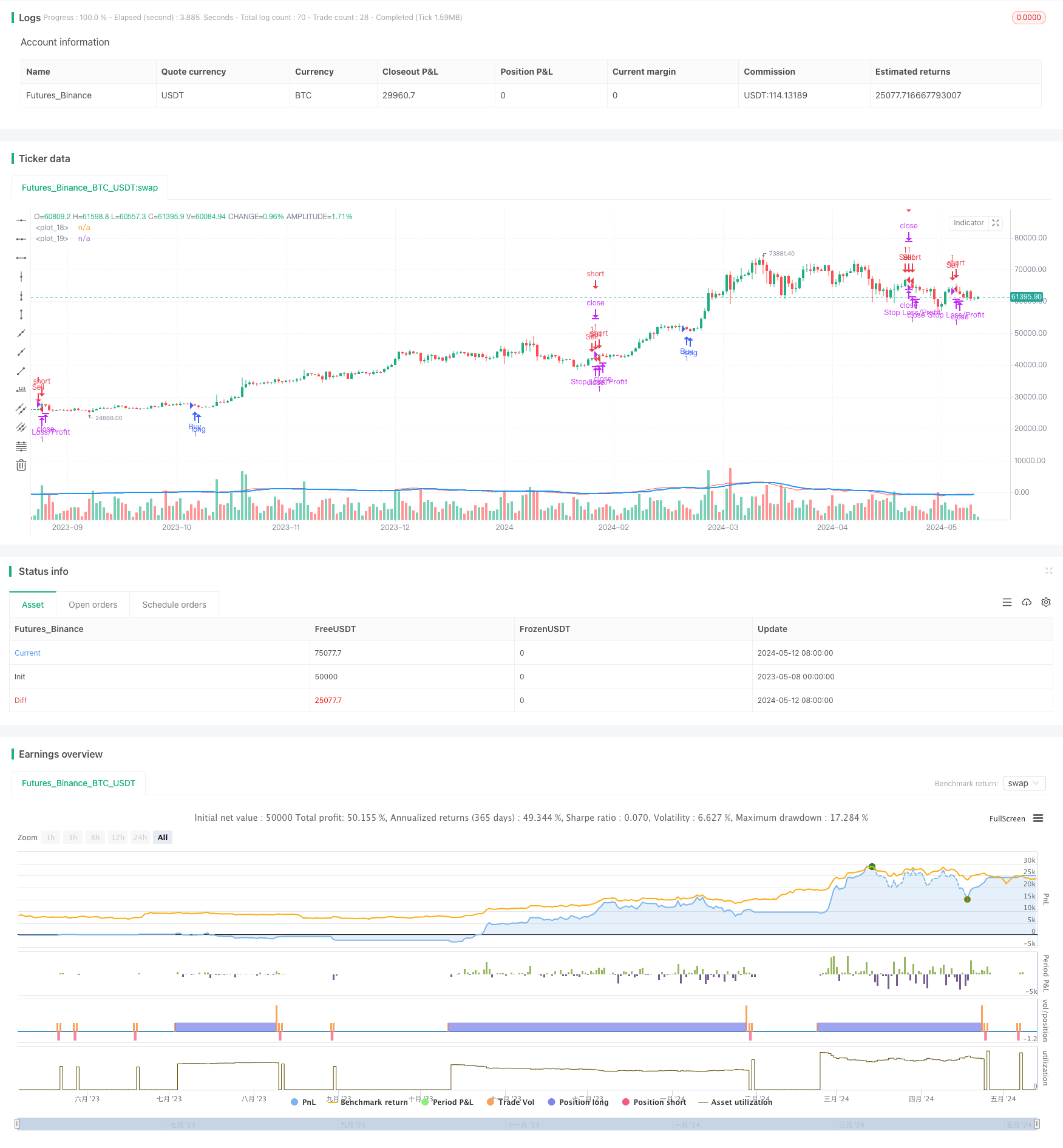
概述
该策略是基于MACD指标的改进版交易策略。它结合了MACD指标的趋势跟踪特性和动量交易的思路,通过分析快速移动平均线和慢速移动平均线之间的差异来产生交易信号。同时,该策略还引入了趋势确认、信号延迟确认、固定百分比止损和止盈等优化手段,以提高策略的稳健性和盈利能力。
策略原理
该策略的核心是MACD指标,它由快速移动平均线(EMA)和慢速移动平均线(EMA)之差构成。当快速EMA与慢速EMA出现交叉时,就会产生买入或卖出信号。具体来说,当MACD线从下向上突破信号线时,产生买入信号;当MACD线从上向下跌破信号线时,产生卖出信号。
除了基本的MACD交叉信号外,该策略还引入了趋势确认机制。它通过与简单移动平均线(SMA)进行比较,判断当前市场是处于上升趋势还是下降趋势。只有在上升趋势中出现买入信号,或者在下降趋势中出现卖出信号,才会真正执行交易操作。这样可以有效避免在震荡市中产生的假信号。
此外,该策略还延长了信号确认时间窗口。即当前K线满足买入或卖出条件,并且前一根K线也满足同样的条件时,才会执行相应的交易。这进一步提高了信号的可靠性。
最后,该策略设置了固定百分比的止损和止盈价位。一旦交易进行,就会根据开仓价计算出止损和止盈价,一旦达到这些价位就会自动平仓。这有助于控制单次交易的风险和收益。
策略优势
- 双重趋势确认:结合了MACD指标和简单移动平均线的趋势判断,可以有效过滤掉震荡市中的假信号。
- 信号延迟确认:要求连续两根K线同时满足买入或卖出条件,提高了信号的可靠性。
- 固定止损止盈:根据固定百分比设置止损止盈价位,有助于控制风险和锁定利润。
- 参数灵活:对于MACD指标的快慢线长度、信号线长度以及趋势判断的SMA周期等参数,都可以灵活设置,以适应不同的市场状况。
策略风险
- 参数优化风险:该策略含有多个参数,不同参数的组合可能带来截然不同的结果。如果参数优化没有做好,可能导致策略在实际应用中表现不佳。
- 趋势识别风险:该策略依赖于对趋势的正确判断,如果趋势识别出现误判,可能导致错误的交易决策。
- 单一指标风险:尽管该策略在MACD的基础上进行了优化,但仍主要依赖于单一指标。在某些特定市场状况下,单一指标可能失灵。
- 回测数据限制:该策略的有效性很大程度上取决于历史数据的质量。如果回测数据与实际市场状况差异较大,可能低估策略的实际风险。
策略优化方向
- 结合其他技术指标:可以考虑引入其他技术指标,如RSI、布林带等,以从多个维度对市场进行分析,提高信号的准确性。
- 动态止损止盈:可以根据市场波动情况,动态调整止损止盈的比例,以更好地适应市场变化。
- 加入仓位管理:可以根据市场趋势的强度、交易信号的质量等因素,动态调整每次交易的仓位大小,以更好地控制风险。
- 引入机器学习:可以尝试将机器学习算法与该策略相结合,通过对历史数据的学习,自动优化参数选择,提高策略的适应性。
总结
该策略是一个基于MACD指标的改进型交易策略,通过趋势确认、信号延迟确认、固定止损止盈等方法,提高了策略的稳健性和盈利潜力。但同时也存在参数优化、趋势识别、单一指标、回测数据等方面的风险。未来可以考虑从结合其他指标、动态止损止盈、仓位管理、机器学习等方面对策略进行优化,以进一步提高其实际应用效果。
策略源码
/*backtest
start: 2023-05-08 00:00:00
end: 2024-05-13 00:00:00
period: 1d
basePeriod: 1h
exchanges: [{"eid":"Futures_Binance","currency":"BTC_USDT"}]
*/
// This Pine Script™ code is subject to the terms of the Mozilla Public License 2.0 at https://mozilla.org/MPL/2.0/
// © sligetit
//@version=5
strategy("Improved MACD_VXI Strategy", overlay=true)
// Calculate MACD and Signal Line
fastLength = input.int(13, title="Fast Length")
slowLength = input.int(21, title="Slow Length")
signalLength = input.int(8, title="Signal Length")
fastMA = ta.ema(close, fastLength)
slowMA = ta.ema(close, slowLength)
macd = fastMA - slowMA
signal = ta.sma(macd, signalLength)
// Plot MACD and Signal Line
plot(macd, color=color.red, linewidth=1)
plot(signal, color=color.blue, linewidth=2)
// Calculate Cross Signals with Trend Confirmation
smaPeriod = input.int(50, title="SMA Period")
sma = ta.sma(close, smaPeriod)
trendUp = close > sma
trendDown = close < sma
crossOver = ta.crossover(signal, macd)
crossUnder = ta.crossunder(signal, macd)
buySignal = crossOver and trendUp
sellSignal = crossUnder and trendDown
// Execute Buy/Sell Operations
if buySignal
strategy.entry("Buy", strategy.long)
if sellSignal
strategy.entry("Sell", strategy.short)
// Extend Signal Confirmation Time Window
longSignal = crossOver[1] and trendUp[1]
shortSignal = crossUnder[1] and trendDown[1]
if longSignal
strategy.entry("Buy", strategy.long)
if shortSignal
strategy.entry("Sell", strategy.short)
// Set Fixed Percentage Stop Loss and Take Profit
stopLossPercent = input.float(1, title="Stop Loss (%)") / 100
takeProfitPercent = input.float(2, title="Take Profit (%)") / 100
stopLossPrice = strategy.position_avg_price * (1 - stopLossPercent)
takeProfitPrice = strategy.position_avg_price * (1 + takeProfitPercent)
strategy.exit("Stop Loss/Profit", "Buy", stop=stopLossPrice, limit=takeProfitPrice)
strategy.exit("Stop Loss/Profit", "Sell", stop=stopLossPrice, limit=takeProfitPrice)
相关推荐